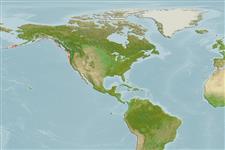Environment: milieu / climate zone / depth range / distribution range
Ecology
Marine; bathydemersal; depth range 800 - 1253 m (Ref. 51661). Deep-water
Northeast Pacific: USA (Washington, Oregon, and northern California south to Monterey Bay) and probably present off British Columbia.
Size / Weight / Age
Maturity: Lm ? range ? - ? cm
Max length : 12.0 cm TL male/unsexed; (Ref. 26773); 11.4 cm SL (female)
Life cycle and mating behavior
Maturity | Reproduction | Spawning | Eggs | Fecundity | Larvae
Stein, D.L., 1978. A review of the deepwater Liparidae (Pisces) from the coast of Oregon and adjacent waters. Proc. Cal. Acad. Sci. 127:1-55. (Ref. 26773)
IUCN Red List Status (Ref. 130435: Version 2024-2)
Threat to humans
Harmless
Human uses
Fisheries: of no interest
Tools
Special reports
Download XML
Internet sources
Estimates based on models
Preferred temperature (Ref.
123201): 3.3 - 4, mean 3.6 °C (based on 4 cells).
Phylogenetic diversity index (Ref.
82804): PD
50 = 0.5000 [Uniqueness, from 0.5 = low to 2.0 = high].
Bayesian length-weight: a=0.00525 (0.00237 - 0.01161), b=3.15 (2.96 - 3.34), in cm total length, based on LWR estimates for this (Sub)family-body shape (Ref.
93245).
Trophic level (Ref.
69278): 3.4 ±0.5 se; based on size and trophs of closest relatives
Resilience (Ref.
120179): High, minimum population doubling time less than 15 months (Preliminary K or Fecundity.).
Fishing Vulnerability (Ref.
59153): Low vulnerability (10 of 100).
